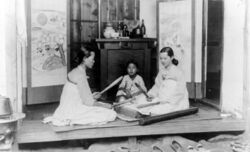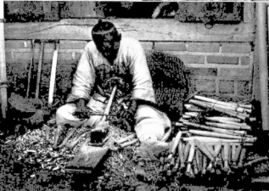Engineering:Dadeumi
| Dadeumi | |
 | |
| Korean name | |
|---|---|
| Hangul | 다듬이 |
| Revised Romanization | Script error: The function "transl" does not exist. |
| McCune–Reischauer | Script error: The function "transl" does not exist. |
| IPA | [da.deum.i] |
Script error: The function "transl" does not exist. (Korean: 다듬이) or Script error: The function "transl" does not exist. (다듬이질) or kinuta (砧) is a Korean traditional ironing method where two women knelt on the floor, facing each other across a smoothing stone, beating out a rhythm on the cloth to press out its wrinkles and soften it.[1]Script error: The function "transl" does not exist. requires Script error: The function "transl" does not exist. (다듬잇방망이) and Script error: The function "transl" does not exist. (다듬잇돌).[2][3] The former is a bat that pounds on the cloth, and the latter is the stone under the cloth.
Also, the cloth is wrapped in a thick round bat, Hongdooggae (홍두깨) (wooden roller used in smoothing cloth)', and Script error: The function "transl" does not exist. is performed. It is used to trim a thin cloth such as ramie fabric (모시) or silk.[4]
History
The 18th-century book, Gyuhap chongseo, details how to do Script error: The function "transl" does not exist. and care for fabrics.[5][6] It is estimated that it would have been used from the 17th to the 18th century.[3] Since ancient times, in Korea, people thought it was a good three sounds to hear the crying of baby, reading a book, and the Script error: The function "transl" does not exist. sound. These three sounds are called Samhuiseong (삼희성; 三喜声). It is because the cheerful sound when doing Script error: The function "transl" does not exist. remind people of healthy vitality, the diligence and stability of everyday life.[5][6][7]
Form and characteristics

Script error: The function "transl" does not exist. are made of granite, agalmatolite, marble, etc. They are also sometimes made of solid wood such as birch wood or zelkova.[5][6] It was made from birch wood in Chungcheongdo or Hamgyeongdo, and in this case it was called the Script error: The function "transl" does not exist. (다듬잇대). The shape is a thick rectangle. The upper surface touching the fabric is made to be slightly wider and smoother than the underside so that the fabric does not hurt. There are four short legs on the four corners of the underside,[5][6] and both of side have grooves for carrying.[3] It is also called Chimseok (침석; 砧石).[5] Script error: The function "transl" does not exist. is a pair of two, made of wood.[8]
Method

First, women dry the starched clothes. Then, women make the clothes wet with water by spraying it with mouth or hand. Women fold the laundry soaked in water into the wrapping cloth, wait until the water spreads evenly, then fold it back. After that, women place the laundry wrapped in a cloth on top of the Script error: The function "transl" does not exist. and beat it with a Script error: The function "transl" does not exist.. When there is one person, grab a bat in both hands and beat. When there are two people, sit face to face with the Script error: The function "transl" does not exist. in the middle. After a certain amount of beat, repeat unfolding and folding, wrinkles of clothes spread and shine.[3] Fabric such as fine silk is arranged on the Script error: The function "transl" does not exist. in the primary, then wrap it in Hongdooggae and beat it.[5][9]
Social and cultural significance

Korean did Script error: The function "transl" does not exist. in late autumn and winter. Until late at night, the sound of two people tapping the cloth to the tone with four bats was one aspect of Korean customs.[3] Script error: The function "transl" does not exist. also meant correcting the mind to the white-clad folk.[10] In other words, it is sometimes referred to as an Ingochim (Korean: 忍苦砧, 인고침), which means that the pain of the heart that is too much to bear is tolerated with the Script error: The function "transl" does not exist.. Each Script error: The function "transl" does not exist. has a different tone. Because there is a favorite sound in each area, it is carved to make a unique sound like a percussion instrument. There are also colorful paintings and colored Script error: The function "transl" does not exist., and there are also Script error: The function "transl" does not exist. with details of the dead. It was a reflection of the preference and culture of the time.[7] Script error: The function "transl" does not exist. was also useful for making cloth for windbreak. When making the hanbok, starched clothes and did Script error: The function "transl" does not exist., the fibers spread and the starched clothes well so that the wind could be blocked well. Furthermore, the surface became less dirty because it became smooth and it was easy to wash because the dirt was falling well.[7] In modern times, the range used in everyday life is reduced, but Script error: The function "transl" does not exist. performances are performed at festivals.[11][12]
Dadeumi in culture
There are Korean cultures related to Script error: The function "transl" does not exist.. "Sound of Dadeumi" (다듬잇소리) is a poem by Yang Ju-dong that depicts the lives and feelings of women who do Script error: The function "transl" does not exist..[7] Yangpyeong folk song (양평민요)[7] expresses a woman who does Script error: The function "transl" does not exist. in simple language. There is also Dadeumi Nori (다듬이놀이) who competes to do better Script error: The function "transl" does not exist..
Dadeumi Nori
Script error: The function "transl" does not exist. (다듬이놀이) is a play performed in Namwon city, Jeollabuk-do. The women sat face to face with the Script error: The function "transl" does not exist. in the middle and contested who was better at Script error: The function "transl" does not exist.. The two people who sit facing each other change the method of fulling according to the pitch of the sound. It removes the boredom of Script error: The function "transl" does not exist.. With the way of washing and the material of the cloth changed in the modern day, it is now rarely played.[13]
See also
- Waulking song, Scottish folksongs sung by women as the worked cloth together
- Fulling, the pounding of woollen cloth
- Washing paddle
References
- ↑ "Korean ironing sticks, clubs, blocks, Japanese fulling mallets" (in en-GB). http://www.oldandinteresting.com/Korean-ironing.aspx.
- ↑ "다듬이돌" (in ko). e-museum. https://terms.naver.com/entry.nhn?docId=2230365&cid=51293&categoryId=51293.
- ↑ 3.0 3.1 3.2 3.3 3.4 "다듬이돌" (in ko). e-museum. https://terms.naver.com/entry.nhn?docId=2224952&cid=51293&categoryId=51293.
- ↑ "홍두깨 | 주요 소장품 검색" (in ko). http://www.museum.go.kr/site/main/relic/search/view?relicId=2271.
- ↑ 5.0 5.1 5.2 5.3 5.4 5.5 Lee, Hun-jong (1997). 민족생활어사전. South Korea: 한길사 (hangilsa). ISBN 9788935630066.
- ↑ 6.0 6.1 6.2 6.3 Kim, Young-sook (1998). 한국복식문화사전. South Korea: 미술문화 (Misul Munhwa). p. 115~144. ISBN 9788986353242.
- ↑ 7.0 7.1 7.2 7.3 7.4 허동화 (2006-02-20). "우리가 정말 알아야 할 우리 규방 문화 - 다듬잇돌" (in ko). 현암사 (Hyeonamsa) (South Korea): pp. 51~56. ISBN 9788932313146. https://terms.naver.com/entry.nhn?docId=1624766&cid=42940&categoryId=42940.
- ↑ "Dadeumitbangmang-i" (in ko). http://krdic.naver.com/detail.nhn?docid=8347500.
- ↑ Cho, Hyo-sun (1989). 한국복식풍속사연구. South Korea: 일지사 (Iljisa). ISBN 9788931201772.
- ↑ "<경주문화엑스포> 세계인의 문화제전 13일 개막" (in ko). 연합뉴스 (Yonhap news). 2003-08-12. http://news.naver.com/main/read.nhn?mode=LSD&mid=sec&sid1=102&oid=001&aid=0000432159.
- ↑ "함양 산골마을에 울려 퍼진 '다듬이 소리'" (in ko). 경남신문 (Gyeongnam News). 2017-11-27. http://www.knnews.co.kr/news/articleView.php?idxno=1233043.
- ↑ "함양서 '추억의 다듬이 소리' 들어보세" (in ko). 경남신문 (Gyeongnam News). 2016-10-12. http://www.knnews.co.kr/news/articleView.php?idxno=1193928.
- ↑ "다듬이놀이" (in ko). http://namwon.grandculture.net/Contents?local=namwon&dataType=01&contents_id=GC00602190.
External links
 |

